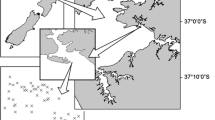Abstract
Water and sediment samples from ten unpolluted sandy beaches have been analysed for various chemical parameters and meiofauna. The results have indicated that, within the range of grain sizes found, (196–337 μm), short term fluctuations in the natural levels of the various chemical constituents do not significantly influence the densities of meiofauna populations. These are, however, governed largely by the median grain size of the sediments. The relationships between median grain size and the population densities of nematodes and harpacticoid copepods have been established. The optimum grain size for the populations studied was 284 μm, and as the sediment size deviated from this, the population density decreased. Thus knowledge of the median grain size of sediments should indicate the approximate meiofaunal density which can be expected in the absence of any other external influence. Deviations from this can then be attributed to perturbation.
Similar content being viewed by others
References
Bartlett, P. D., Eagle, G. A., Fricke, A. H., Greenwood, P. J., Hennig, H. F.-K. O., and Kenmuir, R. M.: 1981, ‘Follow-up Pollution Survey of Camps Bay Beach, CSIR Report T/SEA 8103, 13 pp.
Benningston, S. I.: 1977, ‘Benthic Macrofauna-substrate Relationships in an Unpolluted and a Polluted Stream Environment’, Mauri Ora 5, 21–37.
Brown, A. C.: 1971, ‘The Ecology of the Sandy Beaches of the Cape Peninsula, South Africa. Part 1. Introduction’, Trans. R. Soc. S. Afr. 39, 247–280.
Dye, A. H.: 1978, ‘An Ecophysiological Study of the Meiofauna of the Swartkops Estuary. 1. The Sampling Sites, Physical and Chemical Features’, Zool. Afr. 13, 1–8.
Dye, A. H. and Fürstenberg, J. P.: 1978, ‘An Ecophysiological Study of the Meiofauna of the Swartkops Estuary. 2. The Meiofauna: Composition, Distribution, Seasonal Fluctuations and Biomass’, Zool. Afr. 13, 19–32.
Flemming, B. W. and Thum, A. B.: 1978, ‘The Settling Tube-a Hydraulic Method for the Grain Size Analysis of Sand’, Kieler Meeresforsch. Sonderheft 4, 82–95.
Fricke, A. H.: 1979, ‘Meiofauna Extraction Efficiency by a Modified Oostenbrink Apparatus’, Helgol. wiss. Meeresunters. 32, 436–443.
Fricke, A. H., Eagle, G. A., Gledhill, W. J., Greenwood, P. J., and Orren, M. J.: 1979, ‘Preliminary Pollution Surveys Around the South-western Cape Coast. Part 1: Mossel Bay’, S. Afr. J. Sci. 75, 453–456.
Harris, T. F. W.: 1978, ‘Review of Coastal Currents in Southern African Waters’, S. Afri. Natl. Sci. Prog. Report No. 30. 103 pp.
Hulings, N. C. and Gray, J. S.: 1976, ‘Physical Factors Controlling Abundance of Meiofauna on Tidal and Atidal Beaches’, Mar. Biol. 34, 77–83.
Jansson, B-O.: 1971, ‘The ‘Umwelt’ of the Interstitial Fauna’, Smithson. Contr. Zool. 76, 129–140.
Johnson, R. G.: 1971, ‘Animal-sediment Relationships in Shallow Water Benthic Communities’, Mar. Geol. 11 93–104.
Lorenzen, S.: 1974, ‘Die Nematodenfauna der sublitroralen Region der Deutschen Bucht, insbesondere im Titan-Abwassergebiet bei Helgoland’, Veroff. Inst. Meeresforsch. Bremerh. 14, 305–327.
Marcotte, B. M. and Coull, B. C.: 1974, ‘Pollution, Diversity and Meiobenthic Communities in the North Adriatic (Bay of Piran, Yugoslavia)’, Vie Millieu, Ser. B. 24, 281–300.
McGlurg, T. P. and Gardner, B. D.: 1977, ‘The Chemical and Biological Recovery of an Organically Polluted Sandy Beach in Natal, South Africa, Following the Diversion of Effluents to an Offshore Pipeline’, Water S.A. 3, 12–16.
McIntyre, A. D. and Murison, O. J.: 1973, ‘The Meiofauna of a Flatfish Nursery Ground’, J. Mar. Biol. Ass. U.K. 53, 93–118.
McLachlan, A. and Fürstenberg, J. P.: 1977, ‘Studies on the Psammolittoral Meiofauna of Algoa Bay, South Africa. III. A Quantitative Analysis of Nematode and Crustacean Communities’, Zool. Afr. 12, 61–72.
Orren, M. J., Fricke, A. H., Eagle, G. A., Greenwood, P. J., and Gledhill, W. J.: 1979, ‘Preliminary Pollution Surveys Around the South-western Cape Coast. Part 2. Green Point Sewage Outfall’, S. Afr. J. Sci. 75, 456–459.
Orren, M. J., Eagle, G. A., Fricke, A. H., Gledhill, W. J., Greenwood, P. J., and Hennig, H. F.-K. O.: 1981, ‘The Chemistry and Meiofauna of Some Unpolluted Sandy Beaches in South Africa’, Water S.A. 7(4), 203–210.
Reid, D. M.: 1939, ‘Salinity Interchange Between Seawater and Sand Overflowing Freshwater at Low Tide’, J. Mar. Biol. Ass. U.K. 16, 609–614.
Saloman, C. H.: 1976, ‘The Benthic Fauna and Sediments of the Nearshore zone of Panama City Beach Florida’, U.S. Coastal Res. Centre, Fort Belvoir, Va. 76(10), 1–256.
Smith, R. I.: 1955, ‘Salinity Variation in Interstitial Water and Sand at Kames Bay, Millport, with Reference to the Distribution of Nereis diversicolor’, J. Mar. Biol. Ass. U.K. 34, 33–46.
Ward, A. R.: 1975, ‘Studies on the Sublittoral Free-living Nematodes of Liverpool Bay. II. Influence of Sediment Composition on the Distribution of Marine Nematodes’, Mar. Biol. 30, 217–225.
Wieser, W.: 1959, ‘The Effect of Grain Size on the distribution of Small Invertebrates Inhabiting the Beaches of Puget Sound’, Limnol. Oceanogr. 4, 181–194.
Wieser, W.: 1975, ‘The Meiofauna as a Tool in the Study of Habitat Heterogeneity: Ecophysiological Aspects. A review’, Cahiers de Biol. Mar. 15, 647–670.
Author information
Authors and Affiliations
Rights and permissions
About this article
Cite this article
Hennig, H.F.K.O., Fricke, A.H., Greenwood, P.J. et al. Relationships between meiofaunal population densities and physico-chemical properties of unpolluted sandy beaches. Environ Monit Assess 1, 337–344 (1982). https://doi.org/10.1007/BF00403834
Received:
Issue Date:
DOI: https://doi.org/10.1007/BF00403834




